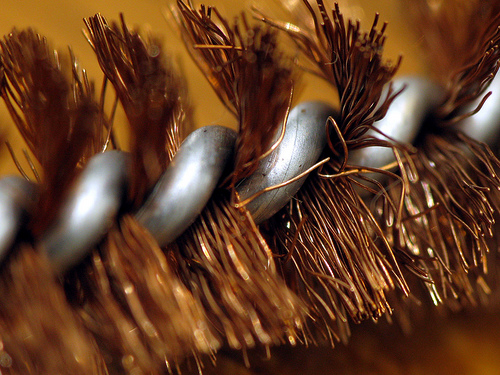Bore Snakes vs Cleaning Rods – Bore Snake Advantages
The primary argument in favor of bore snakes is that they reduce the chance of damaging your gun’s chamber or muzzle through wear. I’m sure we’ve all seen old military rifles with work out muzzles or that had to be counter-bored to fix a worn out muzzle area. This happens from regular use of a steel cleaning rod with no guide, which combined with the inevitable grit that collects on a gun, wears down the muzzle area. And if you’ve just purchased a beautiful Smith & Wesson 686 revolver, the last thing you’d want is to damage its accuracy by manhandling a cleaning rod down its muzzle end.
Obviously soft aluminum or brass cleaning rods help offset that worry, but the problem of grit sticking to the rod and wearing away over time remains. Likewise, while it’s almost always a good idea to clean your barrel from the chamber end, minimizing muzzle damage, it’s often impossible—try sticking an 8-inch cleaning rod from the chamber end of a revolver.
So . . . the compromise: bore snakes. There are two kinds of bore snakes, some like this one from Sage and Braker:
This allows you to mount a bore brush directly to the bore snake itself, which allows for greater flexibility in cleaning. Reminiscent of old European military cleaning kits, the Sage and Braker is probably the most advanced bore snake on the market, as it works with nearly every caliber with just a simple change of the brush and allows you to use more aggressive brushes if needed. It is quite possibly a true cleaning rod replacement.
On the better known end of the bore snake spectrum are the famous Hoppes bore snakes:
These have built in caliber specific brushes and require you to purchase multiple bore snakes for your guns. This can become a rather expensive habit fairly quickly if you have a lot of different calibers, but if you don’t, this is an easy and quick way of cleaning your barrels. Again, since you’d want to clean your barrels from the chamber end, using a bore snake makes this practice possible on revolvers.
Bore Snakes vs Cleaning Rods – Cleaning Rod Advantages
Of course, if you’re careful and can stick a cleaning rod down the chamber end of a gun, a cleaning rod is generally better (i.e., cleans better) than a bore snake.
One-piece cleaning rods are the strongest, and they are typically made from more durable materials and do not break down for easy storage. Fine to stick in the gun safe or back of the cabinet, not so handy for carrying to the range or hunting.
Multi-piece jointed cleaning rods take up little room, but are usually made of soft materials to protect your bore, and can bend, flex and break at the joints. This is fine if you are doing normal cleaning, but if you have a neglected or heavily fouled bore, the heavy effort to clean it could destroy your cleaning rod.
With cleaning rods, we again have two popular options. The first are the traditional jointed cleaning rods like the ones found in this Hoppes Universal Cleaning accessory kit:
Or single piece carbon fiber, fiberglass, or coated metal rods like this really nice carbon fiber rod from Tipton:
Naturally, there are dozens more variations on these two themes, but it boils down to either a single piece rod, or a rod made of jointed sections you screw together. Each have their pros and cons. As I mentioned earlier, if used incorrectly, cleaning rods can wear down the muzzle on firearms, which makes using a cleaning rod guide an absolute must:
Bore Snakes vs Cleaning Rods – Conclusion
Well, it’s a little from column A and a little from column B. My personal choice for every day work is the Sage and Braker. It has all the advantages of a bore snake, with the usefulness of using regular bore brushes. Toss the snake itself in the laundry when it gets dirty and change out the brushes as you need them, making it a truly universal bore snake solution. I even like to soak the area just above the brush in solvents or oil to better distribute them through the bore and aid in cleaning as I pass the snake down the barrel.
Of course, it really also depends on what kind of gun you’re cleaning. I own quite a few semi-auto pistols, and with these weapons, where you can insert the brush through the chamber end, I don’t really feel a need to get a bore snake. Since I’m careful when cleaning, a regular cleaning rod is fine, and it’s generally a three-piece brass cleaning rod. This is also my go-to cleaner when I buy used guns for the first time and want to really scrub the crap out of them.
Maybe I’m old fashioned, but I prefer a cleaning rod for a deep down scrubbing. It’s also the one I keep in my range bag, as it’s cheaper to lose a cheap cleaning rod than a nice bore snake, and I don’t feel bad about loaning it out and never getting it back. Plus, it’s good to have a spare.
In the end? A high end bore snake is probably the absolute best way to go if you can’t clean your gun from the chamber end, and if your gun is new and/or doesn’t need a thorough cleaning. If you can clean from the chamber end and/or you gun is really dirty, then a single piece cleaning rod made of carbon fiber or coated polymer works fine. Keeping bores clean is critical for accuracy and performance, and there is no reason to skimp on buying your primary cleaning tool. Buy a good bore snake and a good cleaning rod, and you’ll be ready for anything.







